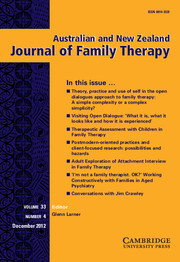Crossref Citations
This article has been cited by the following publications. This list is generated based on data provided by
Crossref.
Carr, Alan
2008.
Thematic review of family therapy journals in 2007.
Journal of Family Therapy,
Vol. 30,
Issue. 3,
p.
296.
Carr, Alan
2008.
Feedback for ANZJFT.
Australian and New Zealand Journal of Family Therapy,
Vol. 29,
Issue. 4,
p.
234.
Larner, Glenn
2009.
Integrating family therapy in adolescent depression: an ethical stance.
Journal of Family Therapy,
Vol. 31,
Issue. 3,
p.
213.
Bickerton, Annemaree
Ward, Julie
Southgate, Michelle
and
Hense, Tiffany
2014.
The Safety First Assessment Intervention: A Whole Family Approach for Young People with High Risk Mental Health Presentations.
Australian and New Zealand Journal of Family Therapy,
Vol. 35,
Issue. 2,
p.
150.
Hannigan, Ben
Edwards, Deborah
Evans, Nicola
Gillen, Elizabeth
Longo, Mirella
Pryjmachuk, Steven
and
Trainor, Gemma
2015.
An evidence synthesis of risk identification, assessment and management for young people using tier 4 inpatient child and adolescent mental health services.
Health Services and Delivery Research,
Vol. 3,
Issue. 22,
p.
1.
Larner, Glenn
2015.
Ethical Family Therapy: Speaking the Language of the Other.
Australian and New Zealand Journal of Family Therapy,
Vol. 36,
Issue. 4,
p.
434.
Sosin, Lisa S.
and
Rockinson-Szapkiw, Amanda J.
2016.
Creative Exposure Intervention as Part of Clinical Treatment for Adolescents Exposed to Bullying and Experiencing Posttraumatic Stress Disorder Symptoms.
Journal of Creativity in Mental Health,
Vol. 11,
Issue. 3-4,
p.
391.
Boston, Paula
and
Cottrell, David
2016.
Trials and Tribulations ‐ an RCT comparing manualized family therapy with Treatment as Usual and reflections on key issues that arose in the implementation.
Journal of Family Therapy,
Vol. 38,
Issue. 2,
p.
172.
Coates, Dominiek
2016.
Client and parent feedback on a Youth Mental Health Service: The importance of family inclusive practice and working with client preferences.
International Journal of Mental Health Nursing,
Vol. 25,
Issue. 6,
p.
526.
Poole, Lucinda A.
Lewis, Andrew J.
Toumbourou, John W.
Knight, Tess
Bertino, Melanie D.
and
Pryor, Reima
2017.
A Multi‐Family Group Intervention for Adolescent Depression: TheBEST MOODProgram.
Family Process,
Vol. 56,
Issue. 2,
p.
317.
Rice, Simon
Halperin, Stephen
Blaikie, Simon
Monson, Katherine
Stefaniak, Rachel
Phelan, Mark
and
Davey, Christopher
2018.
Integrating family work into the treatment of young people with severe and complex depression: a developmentally focused model.
Early Intervention in Psychiatry,
Vol. 12,
Issue. 2,
p.
258.
Isaacs, Serena Ann
Roman, Nicolette Vanessa
Savahl, Shazly
and
Sui, Xin‐Cheng
2018.
Using the RE‐AIM framework to identify and describe best practice models in family‐based intervention development: A systematic review.
Child & Family Social Work,
Vol. 23,
Issue. 1,
p.
122.
Grenyer, Brin F. S.
Bailey, Rachel C.
Lewis, Kate L.
Matthias, Michael
Garretty, Toni
and
Bickerton, Annemaree
2019.
A Randomized Controlled Trial of Group Psychoeducation for Carers of Persons With Borderline Personality Disorder.
Journal of Personality Disorders,
Vol. 33,
Issue. 2,
p.
214.
Young, Jennifer
Conrad, Agatha
and
Mah, Beth
2019.
A Pilot Study to Explore the Influence of the ‘Safety First Assessment Intervention’ on the Family Environment.
Australian and New Zealand Journal of Family Therapy,
Vol. 40,
Issue. 2,
p.
190.
Brown, Jenny
2020.
Engaging with Parents in Child and Adolescent Mental Health Services.
Australian and New Zealand Journal of Family Therapy,
Vol. 41,
Issue. 2,
p.
145.
Van Dongen, Thirsa
Sabbe, Bernard
and
Glazemakers, Inge
2020.
Collaboration for children with complex needs: What adolescents, parents, and practitioners tell us.
Journal of Child Health Care,
Vol. 24,
Issue. 1,
p.
19.
Sharma, Vartika
Hendon, Jessica
Churchill, Rachel
Fortune, Sarah
Simmons, Magenta
Bowden, Linda
and
Hetrick, Sarah
2021.
Improving child and youth mental health: Stakeholder perspectives from a cross-sectional survey to inform research priorities.
Mental Health & Prevention,
Vol. 22,
Issue. ,
p.
200201.
Evans, Nicola
Edwards, Deborah
Carrier, Judith
Elliott, Mair
Gillen, Elizabeth
Hannigan, Ben
Lane, Rhiannon
and
Williams, Liz
2023.
Mental health crisis care for children and young people aged 5 to 25 years: the CAMH-Crisis evidence synthesis.
Health and Social Care Delivery Research,
p.
1.
White, Jennifer H.
Harrison, Jennifer
and
Fleming, Reg
2024.
Clinical Supervision, Workplace Culture, and Therapeutic Engagements with Youth at Risk for Suicide.
Journal of Constructivist Psychology,
Vol. 37,
Issue. 3,
p.
274.




